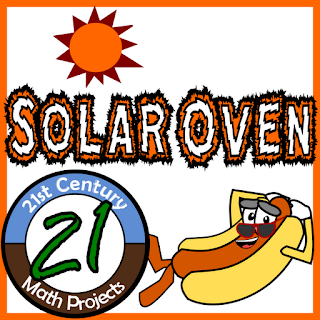 |
| Lunch the 21st Century Math Project way |
If you are trying to integrate an international flair into your science and math curriculum, this 21st Century Math Project is a great place to start. Students will design, build, test, and present a solar oven design with the objective of heating a hot dog the hottest. This is a hands-on STEM project for hands-on students. This works great when integrated scatterplots, best-fit functions, with energy. There are plenty of great opportunities to extend this learning into the humanities as well! Temperature probes with TI’s work great! Any will do.
Name: Solar Oven
Suggested Grade Level: 7-12 (Advanced Algebra, Algebra II or Precalculus skills)
Math Concepts: Scatterplot, Creating, Using and Analyzing Regression Functions, Data Collection
Interdisciplinary Connections: Science, Heat & Energy, Global Studies
Teaching Duration: 4-5 Days (can be modified)
Cost: $5 for a 9 Page PDF (1 project and handouts)
PDF Version: Solar Oven @ TPT
The Product: Students will use their solar ovens to heat a hot dog and will measure its temperature over time. And eat!
 |
| Whoopdidoo! Like this applies to your content area! Good grief! |
At our school we had a local professor speak to an entire school body. Essentially, his work was developing large scale, efficiency solar cookers that he could then take to some of the poorest communities in Africa. To me that sure sounded like a 21st Century Math Project!
Of course I did not invent the idea of a Solar Oven project, but in most iterations I could find, most of them were science specific. As with a few of my other projects, science is the ideal fit for both mathematical rigor and real world relevancy. The challenge is to build up the mathematics side of these traditionally science activities, identify the core math concepts in play and concentrate on teaching these skills. In terms of Solar Ovens, regression functions, (exponential functions specifically) are at the core when heating or cooling. If you are teaching lines of best fit (or your students have this skill), there’s no reason this can’t be extended to work in your classroom.
 |
| An actual authentic application…? Did I take the wrong bus this morning? |
The best, simple, Solar Oven designs I have seen is with a modified pizza box. Fortunately high school kids eat pizza so these contraptions are usually available. There are plenty of possible designs that are one Google away from helping your students on their journey. I would suggest that the design component of your project should take place in a computer lab for the resources.
This is another project that can easily draw in the community. If there are local engineers that want to get out of their cubicle, walk in the sunlight and stuff, it’s a great way to get your students in contact with professionals outside of the school. I’ve been very fortunate with my engineer contacts. They always come with and provide invaluable classroom support. They also like it a lot! Give it a whirl and make the contact and I wouldn’t be surprised if they become an annual fixture!
 |
| How might we use this knowledge to help the global community? |
EXTENSION: There are endless possibilities. Creating PSAs. Entering Science Fairs. Building a large scale oven with the help of engineers to send it to a developing country. Comparing and contrasting the results of morning classes and afternoon class results. It’s a matter of how far you want to step.
If you give a man a hot dog cooked with the sun, they’ll eat it, but if you teach a man to cook a hot dog with the sun, it’s a 21st Century Math Projects. In the event of the forthcoming Zombie Apocalypse, you can’t take for granted things like grills, ovens and microwaves. This might be the only means.


